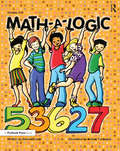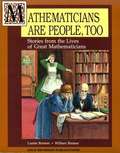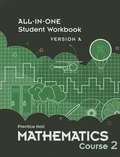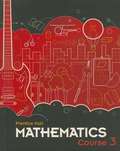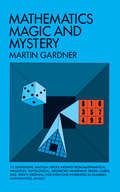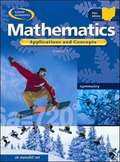- Table View
- List View
Math-a-Logic: Grades 4-8
by Dianne DrazeIf you thought math was all numbers, you're in for a surprise. The ability to reason logically is both a prerequisite for learning mathematics and a desired outcome of mathematics instruction. Mathematics provides an excellent context in which to make students aware of the logical structures they need to function successfully in any setting. Math-A-Logic is an award-winning text that successfully merges logical thinking with mathematical concepts and calculations. Eight areas of logic are introduced: patterns and sequences, analogies, deduction, inference, sets and Venn diagram, propositions and logical notation, syllogisms, and logical problem solving. Attractive, reproducible worksheets lead students through each topic, providing explanations, examples, and exercises to test their understanding. With mathematics as the vehicle for presenting and practicing the logical concept, students get practice in mathematical concepts and computations while building thinking skills. The end result is clearer thinking and enhanced problem-solving abilities. This unique approach is sure to be a favorite supplement to your regular math program. The attractive illustrations, clear instructions, solid content, and ease of use make this book a winner. This book is the winner of Learning Magazine's Teacher Choice award. Grades 4-8
MathScape: Seeing and Thinking Mathematically, Course 2
by Glencoe Mcgraw-HillNIMAC-sourced textbook
Mathematical Connections: A Bridge to Algebra and Geometry
by Francis J. Gardella Patricia R. Fraze Joanne E. Meldon Marvin S. WeingardenMathematical Connections is a bridge that will take you from where you are in your study of mathematics to algebra and geometry. Since topics in mathematics are connected, this course will also lead you to data analysis and probability.
Mathematicians Are People, Too: Stories From The Lives Of Great Mathematicians (Volume One)
by Luetta Reimer Wilbert ReimerVolume One focuses on moments of mathematical discovery experienced by Thales, Pythagoras, Hypatia, Galileo, Pascal, and others.
Mathematics
by David J. Chard Earlene J. Hall Edward B. Burger Jennie M. Bennett Paul A. Kennedy Freddie L. Renfro Tom W. Roby Janet K. Scheer Bert K. WaitsThe topics described in the Standards for Mathematical Content will vary from year to year. However, the way in which you learn, study, and think about mathematics will not. The Standards for Mathematical Practice describe skills that you will use in all of your math courses.
Mathematics 2, Florida
by Glenda Lappan James T. Fey William M. Fitzgerald Susan N. Friel Elizabeth Difanis PhillipsNIMAC-sourced textbook
Mathematics Application and Concepts: Course 3 (New York Edition)
by McGraw-HillYour textbook also gives you many opportunities to master the Mathematics Performance Indicators. Take time each day to do at least one sample problem either from the Countdown or from the lesson you are studying.
Mathematics Course 2 All-In-one Student Workbook Version A
by Prentice HallCourse 2 consists of a structured approach to a variety of topics such as ratios, percents, equations, inequalities, geometry, graphing and probability. Test Taking Strategies provide a guide to problem solving approaches that are necessary for success on standardized tests. Checkpoint Quizzes assess student understanding after every few lessons. Daily Guided Problem Solving in the text is supported by the Guided Problem Solving worksheet expanding the problem, guiding the student through the problem solving process and providing extra practice.
Mathematics Course 3
by Randall I. CharlesChapters 1-3 focus on integers, rational numbers and real numbers in order to set the stage for equations, inequalities and functions. Real-World applications to the more abstract algebraic concepts are found throughout the text. More than 5 Activity Labs per chapter ensure students receive the visual and special instruction necessary to conceptualize these abstract concepts and prepare them for advanced math courses.
Mathematics, Magic and Mystery
by Martin GardnerWhy do card tricks work? How can magicians do astonishing feats of mathematics mentally? Why do stage "mind-reading" tricks work? As a rule, we simply accept these tricks and "magic" without recognizing that they are really demonstrations of strict laws based on probability, sets, number theory, topology, and other branches of mathematics.This is the first book-length study of this fascinating branch of recreational mathematics. Written by one of the foremost experts on mathematical magic, it employs considerable historical data to summarize all previous work in this field. It is also a creative examination of laws and their exemplification, with scores of new tricks, insights, and demonstrations. Dozens of topological tricks are explained, and dozens of manipulation tricks are aligned with mathematical law.Nontechnical, detailed, and clear, this volume contains 115 sections discussing tricks with cards, dice, coins, etc.; topological tricks with handkerchiefs, cards, etc.; geometrical vanishing effects; demonstrations with pure numbers; and dozens of other topics. You will learn how a Moebius strip works and how a Curry square can "prove" that the whole is not equal to the sum of its parts.No skill at sleight of hand is needed to perform the more than 500 tricks described because mathematics guarantees their success. Detailed examination of laws and their application permits you to create your own problems and effects.
Mathematics: Applications and Concepts (Course Three)
by McGraw-HillSetting the standard in middle school mathematics Mathematics: Applications and Concepts is a three-course middle school series intended to bridge the gap from elementary mathematics to Algebra 1. The program is designed to motivate your students, enable them to see the usefulness of mathematics in the world around them, enhance their fluency in the language of mathematics, and prepare them for success in algebra and geometry.
Mathematics: Applications and Concepts, Course 2 [Grade 7] Ohio
by Roger Day Patricia Frey Rhonda BaileyMathematics: Applications and Concepts is a three-text Middle School series intended to bridge the gap from Elementary Mathematics to High School Mathematics. The program is designed to motivate middle school students, enable them to see the usefulness of mathematics in the world around them, enhance their fluency in the language of mathematics, and prepare them for success in Algebra and Geometry.

